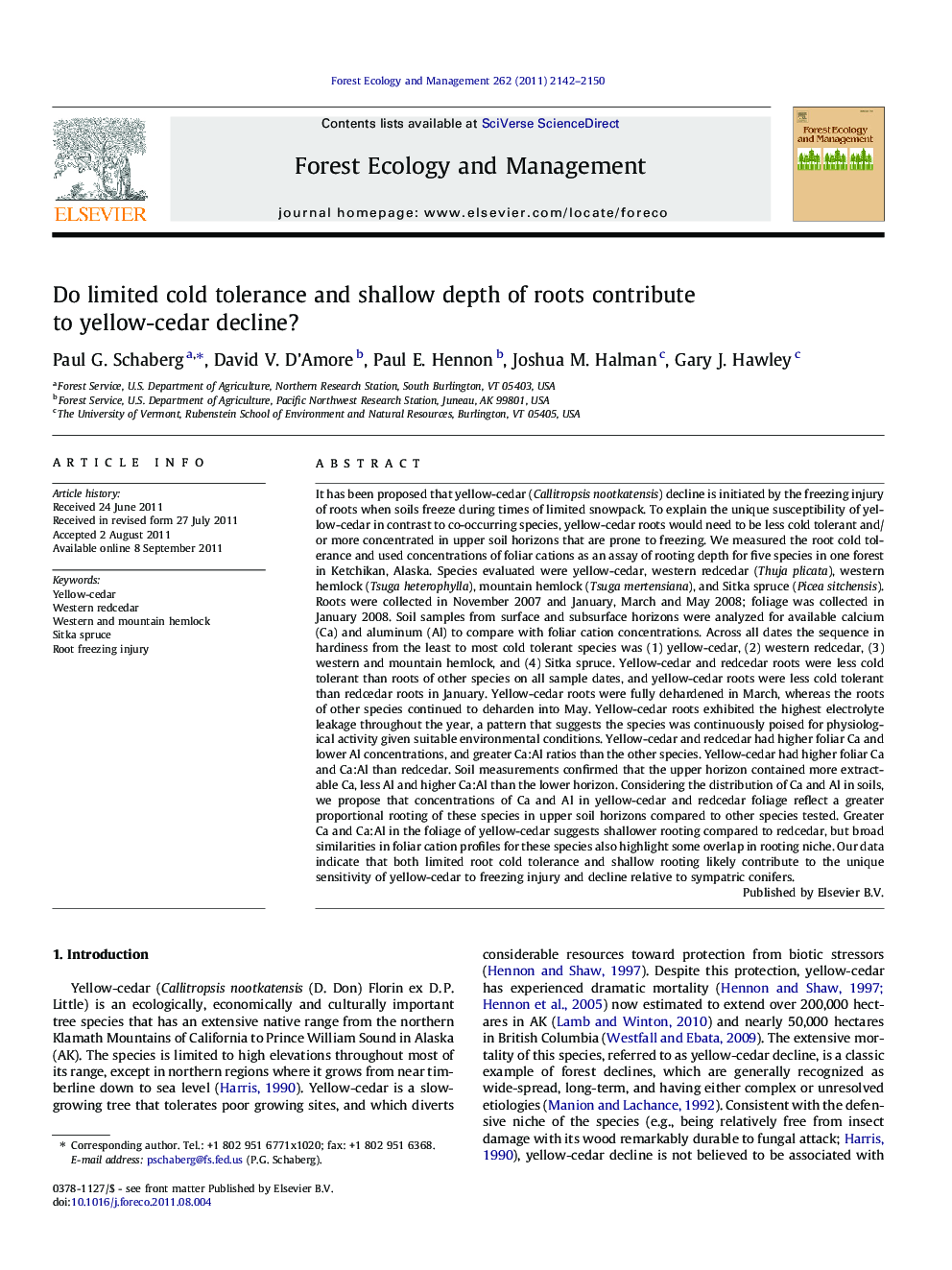| کد مقاله | کد نشریه | سال انتشار | مقاله انگلیسی | نسخه تمام متن |
|---|---|---|---|---|
| 87801 | 159267 | 2011 | 9 صفحه PDF | دانلود رایگان |

It has been proposed that yellow-cedar (Callitropsis nootkatensis) decline is initiated by the freezing injury of roots when soils freeze during times of limited snowpack. To explain the unique susceptibility of yellow-cedar in contrast to co-occurring species, yellow-cedar roots would need to be less cold tolerant and/or more concentrated in upper soil horizons that are prone to freezing. We measured the root cold tolerance and used concentrations of foliar cations as an assay of rooting depth for five species in one forest in Ketchikan, Alaska. Species evaluated were yellow-cedar, western redcedar (Thuja plicata), western hemlock (Tsuga heterophylla), mountain hemlock (Tsuga mertensiana), and Sitka spruce (Picea sitchensis). Roots were collected in November 2007 and January, March and May 2008; foliage was collected in January 2008. Soil samples from surface and subsurface horizons were analyzed for available calcium (Ca) and aluminum (Al) to compare with foliar cation concentrations. Across all dates the sequence in hardiness from the least to most cold tolerant species was (1) yellow-cedar, (2) western redcedar, (3) western and mountain hemlock, and (4) Sitka spruce. Yellow-cedar and redcedar roots were less cold tolerant than roots of other species on all sample dates, and yellow-cedar roots were less cold tolerant than redcedar roots in January. Yellow-cedar roots were fully dehardened in March, whereas the roots of other species continued to deharden into May. Yellow-cedar roots exhibited the highest electrolyte leakage throughout the year, a pattern that suggests the species was continuously poised for physiological activity given suitable environmental conditions. Yellow-cedar and redcedar had higher foliar Ca and lower Al concentrations, and greater Ca:Al ratios than the other species. Yellow-cedar had higher foliar Ca and Ca:Al than redcedar. Soil measurements confirmed that the upper horizon contained more extractable Ca, less Al and higher Ca:Al than the lower horizon. Considering the distribution of Ca and Al in soils, we propose that concentrations of Ca and Al in yellow-cedar and redcedar foliage reflect a greater proportional rooting of these species in upper soil horizons compared to other species tested. Greater Ca and Ca:Al in the foliage of yellow-cedar suggests shallower rooting compared to redcedar, but broad similarities in foliar cation profiles for these species also highlight some overlap in rooting niche. Our data indicate that both limited root cold tolerance and shallow rooting likely contribute to the unique sensitivity of yellow-cedar to freezing injury and decline relative to sympatric conifers.
► We propose that yellow-cedar decline is initiated by root freezing injury.
► We compared the root cold tolerance of yellow-cedar and four sympatric conifers.
► Yellow-cedar was the least cold tolerant of the species assessed.
► Yellow-cedar also had the highest foliar Ca:Al ratio – suggesting shallow rooting.
► Limited cold tolerance and shallow roots likely contribute to yellow-cedar decline.
Journal: Forest Ecology and Management - Volume 262, Issue 12, 15 December 2011, Pages 2142–2150